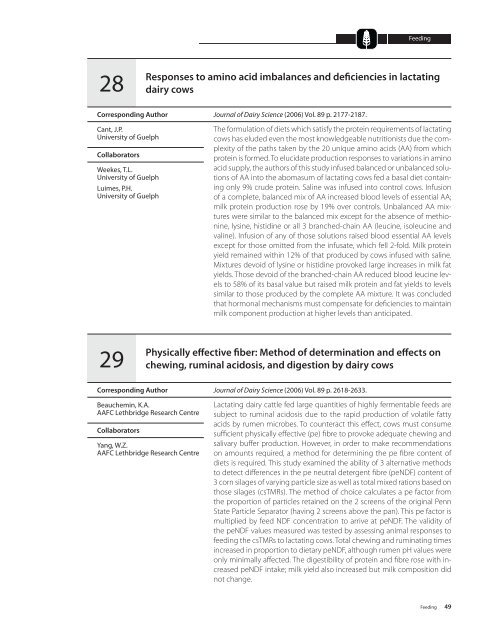A52-75-2007E.pdf - AgroMedia International Inc
A52-75-2007E.pdf - AgroMedia International Inc
A52-75-2007E.pdf - AgroMedia International Inc
Create successful ePaper yourself
Turn your PDF publications into a flip-book with our unique Google optimized e-Paper software.
Feeding28Responses to amino acid imbalances and deficiencies in lactatingdairy cowsCorresponding AuthorCant, J.P.University of GuelphCollaboratorsWeekes, T.L.University of GuelphLuimes, P.H.University of GuelphJournal of Dairy Science (2006) Vol. 89 p. 2177-2187.The formulation of diets which satisfy the protein requirements of lactatingcows has eluded even the most knowledgeable nutritionists due the complexityof the paths taken by the 20 unique amino acids (AA) from whichprotein is formed. To elucidate production responses to variations in aminoacid supply, the authors of this study infused balanced or unbalanced solutionsof AA into the abomasum of lactating cows fed a basal diet containingonly 9% crude protein. Saline was infused into control cows. Infusionof a complete, balanced mix of AA increased blood levels of essential AA;milk protein production rose by 19% over controls. Unbalanced AA mixtureswere similar to the balanced mix except for the absence of methionine,lysine, histidine or all 3 branched-chain AA (leucine, isoleucine andvaline). Infusion of any of those solutions raised blood essential AA levelsexcept for those omitted from the infusate, which fell 2-fold. Milk proteinyield remained within 12% of that produced by cows infused with saline.Mixtures devoid of lysine or histidine provoked large increases in milk fatyields. Those devoid of the branched-chain AA reduced blood leucine levelsto 58% of its basal value but raised milk protein and fat yields to levelssimilar to those produced by the complete AA mixture. It was concludedthat hormonal mechanisms must compensate for deficiencies to maintainmilk component production at higher levels than anticipated.29Physically effective fiber: Method of determination and effects onchewing, ruminal acidosis, and digestion by dairy cowsCorresponding AuthorBeauchemin, K.A.AAFC Lethbridge Research CentreCollaboratorsYang, W.Z.AAFC Lethbridge Research CentreJournal of Dairy Science (2006) Vol. 89 p. 2618-2633.Lactating dairy cattle fed large quantities of highly fermentable feeds aresubject to ruminal acidosis due to the rapid production of volatile fattyacids by rumen microbes. To counteract this effect, cows must consumesufficient physically effective (pe) fibre to provoke adequate chewing andsalivary buffer production. However, in order to make recommendationson amounts required, a method for determining the pe fibre content ofdiets is required. This study examined the ability of 3 alternative methodsto detect differences in the pe neutral detergent fibre (peNDF) content of3 corn silages of varying particle size as well as total mixed rations based onthose silages (csTMRs). The method of choice calculates a pe factor fromthe proportion of particles retained on the 2 screens of the original PennState Particle Separator (having 2 screens above the pan). This pe factor ismultiplied by feed NDF concentration to arrive at peNDF. The validity ofthe peNDF values measured was tested by assessing animal responses tofeeding the csTMRs to lactating cows. Total chewing and ruminating timesincreased in proportion to dietary peNDF, although rumen pH values wereonly minimally affected. The digestibility of protein and fibre rose with increasedpeNDF intake; milk yield also increased but milk composition didnot change.Feeding 49





